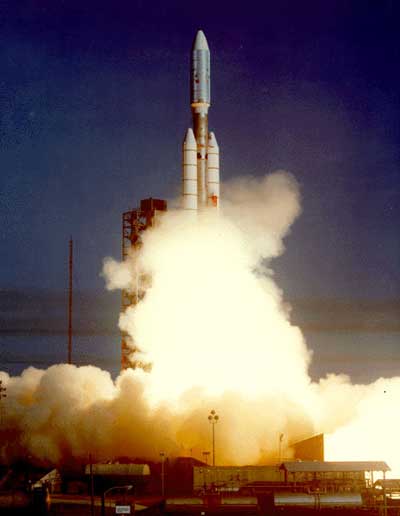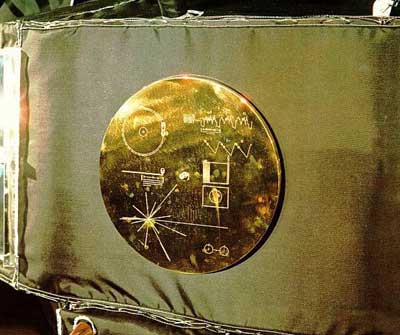Voyager 2Voyager 2 was one of a pair of spacecraft launched to explore the planets of the outer solar system and the interplanetary environment. Each Voyager had as its major objectives at each planet to:
Voyager 2 was launched on August 20, 1977, from Cape Canaveral. The spacecraft was launched by a Titan IIIE-Centaur rocket.
Power was provided to the spacecraft systems and instruments through the use of three radioisotope thermoelectric generators. The RTGs were assembled in tandem on a deployable boom hinged on an outrigger arrangement of struts attached to the basic structure. Each RTG unit, contained in a beryllium outer case, was 40.6 cm in diameter, 50.8 cm in length, and weighed 39 kg. The RTGs used a radioactive source (Plutonium-238 in the form of plutonium oxide, or PuO2, in this case) which, as it decayed, gave off heat. A bi-metallic thermoelectric device was used to convert the heat to electric power for the spacecraft. The total output of RTGs slowly decreases with time as the radioactive material is expended. Therefore, although the initial output of the RTGs on Voyager was approximately 470 W of 30 V DC power at launch, it had fallen off to approximately 335 W by the beginning of 1997 (about 19.5 years after launch). Communications were provided through the high-gain antenna with a low-gain antenna for backup. The high-gain antenna supported both X-band and S-band downlink telemetry. Voyager was the first spacecraft to utilize X-band as the primary telemetry link frequency. Data could be stored for later transmission to Earth through the use of an on-board digital tape recorder. Voyager, because of its distance from Earth and the resulting time-lag for commanding, was designed to operate in a highly-autonomous manner. In order to do this and carry out the complex sequences of spacecraft motions and instrument operations, three interconnected on-board computers were utilized. The Computer Command Subsystem (CCS) was responsible for storing commanding for the other two computers and issuing the commands at set times. The Attitude and Articulation Control Subsystem (AACS) was responsible for controlling spacecraft attitude and motions of the scan platform. The Flight Data Subsystem (FDS) controlled the instruments, including changes in configuration (state) or telemetry rates. All three computers had redundant components to ensure continued operations. The AACS included redundant star trackers and Sun sensors as well.
Originally planned as a Grand Tour of the outer planets, including dual launches to Jupiter, Saturn, and Pluto in 1976 and 1977 and dual launches to Jupiter, Uranus, and Neptune in 1979, budgetary constraints caused a dramatic rescoping of the project to two spacecraft, each of which would go to only Jupiter and Saturn. The new mission was called Mariner Jupiter/Saturn, or MJS. The mission was renamed Voyager about six months prior to launch. The rescoped mission was estimated to cost $250 million (through the end of Saturn operations), only a third of what the Grand Tour design would have cost. Voyager 2 was the first of the two spacecraft to be launched, with liftoff occurring on August 20, 1977. Shortly after lift-off, problems with the deployment of the science boom were detected. Several months after launch, in April of 1978, Voyager 2's primary radio receiver failed, automatically kicking in the backup receiver which proved to be faulty. Attempts to recover the use of the primary receiver failed and the backup receiver was used for the remainder of the mission. Although use of the backup receiver made communication with the spacecraft more difficult, engineers were able to find workarounds.
The scientists and engineers who designed Voyager and the mission, had considered the possibility of an extended mission to Uranus and Neptune. As a result of the success of the Jupiter and Saturn flybys, approval was granted to extend the mission, first to Uranus, then to Neptune and later to continue observations well past Neptune. Voyager 2 made successful flybys of Uranus (January 24, 1986) and Neptune (August 25, 1989). Because of the additional distance of these two planets, adaptations had to made to accomodate the lower light levels and decreased communications. Voyager 2 was successfully able to obtain about 8,000 images of Uranus and its satellites. Additional improvements in the on-board software and use of image compression techniques allowed about 10,000 images of Neptune and its satellites to be taken. Rechristened the Voyager Interstellar Mission (VIM) by NASA in 1989 after its encounter with Neptune, Voyager 2 continued operations, taking measurements of the interplanetary magnetic field, plasma, and charged particle environment while searching for the heliopause (the distance at which the solar wind becomes subsumed by the more general interstellar wind). Through the end of the Neptune phase of the Voyager project, a total of $875 million had been expended for the construction, launch, and operations of both Voyager spacecraft. An additional $30 million was allocated for the first two years of VIM. Voyager 2 is currently speeding away from the Sun at a velocity of about 3.13 AU/year. References:
|


